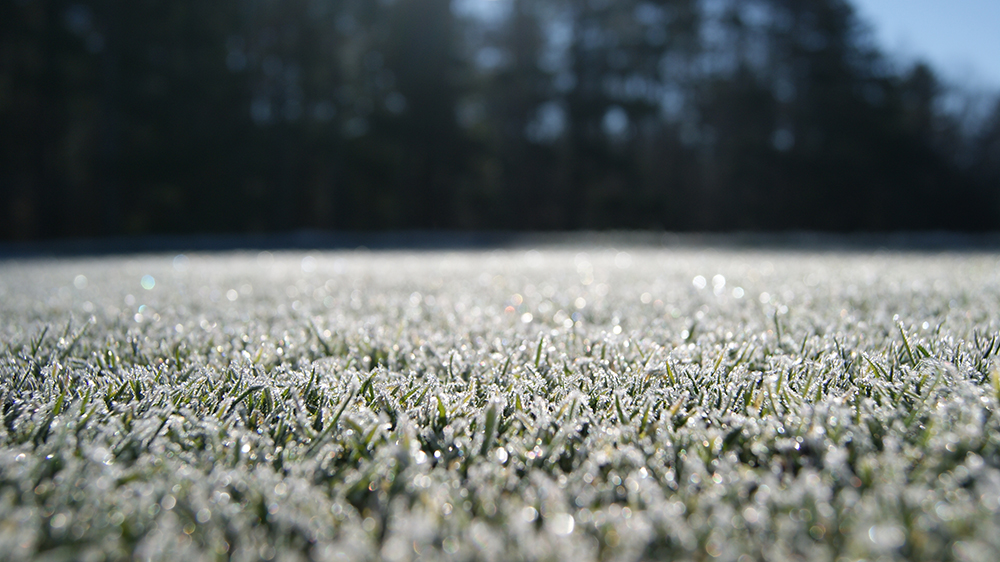Whilst not known for extreme weather conditions, the UK climate can provide challenges for managing turfgrass surfaces during the winter months. Periods of waterlogging, limited light, disease pressure, and fluctuating temperatures place significant physiological strain on turfgrass, particularly on intensively managed playing surfaces.
Cool season grass species such as fescue, bent grasses and rye grass are generally well adapted to cold weather conditions. Even so, turfgrass resilience to winter stresses can be improved by the grass plants own physiological responses to the onset of winter and by the various mechanical, nutritional and biostimulatory management practices that can be employed to support this.
Temperature, growth rates and stress resilience
Like all plants, turfgrass growth can be restricted by a reduction in any one of the key factors for growth: light, water, air, nutrients and the right temperature. During the winter months grass growth usually slows due to limited rates of photosynthesis in response to lower temperatures and light levels. Cool season turfgrass species reach peak growth potential at around 15-25°C and drops to around 20% when temperatures fall below 10°C. This reduced growth rate leads to a reduction in wear tolerance, a potential for diminished sward density and increased susceptibility to disease. In addition to reduced growth rates, low temperatures can also lead to degradation of cell components like chlorophyll, alter cell membrane strength, and affect osmotic regulation (Keough, 2016).
Adaptation to cold temperatures
As cooler weather arrives, plants undertake a process known as hardening or cold acclimation to enhance their ability to survive periods of cold temperatures. The acclimation process in cool season grasses is triggered by temperatures consistently below 4°C and reduced light levels (Kvalbein, et al., 2017). This natural adaptation enhances plant tolerance to low temperatures, oxidative stress, and disease.
Key acclimatory responses in cool season turfgrasses include:
· Increased carbohydrate storage in roots and crowns, fuelling respiration during dormancy.
· Altered lipid composition of cell membranes, improving cold tolerance and cell stability.
· Upregulation of antifreeze proteins and antioxidants, reducing damage from freeze-thaw cycles.
· Downregulation of shoot growth, enabling energy reallocation to roots and structural protection.
Turfgrass that has been stimulated into growth, for example through application of fertiliser or by increasing temperatures, is less tolerant of winter stresses than plants that have stopped growing due to acclimation. Winters in the UK, therefore, can be difficult for turfgrass to cope with because the temperature is frequently cold enough to reduce growth rates, and therefore reduce ability to outgrow disease and other stresses, but not cold enough to facilitate prolonged acclimation.

Supporting turfgrass carbohydrate storage
Maximising plant health and minimising the impact of external stress factors on turfgrass surfaces can be achieved by enhancing the plants own ability to withstand stress. In the context of winter stress, it is beneficial to undertake practices that increase carbohydrate storage prior to the onset of cold weather. As part of the cold acclimation process, soluble sugars created through the process of photosynthesis are stored in plant cells providing an energy reserve which the plant can draw on when conditions are suitable for growth (Ostrem, et al., 2011). Applying biostimulants that contain carbohydrates can help to increase the plants carbohydrate content improving cold tolerance and regrowth potential. Alternatively, plants can be encouraged to regulate carbohydrates more effectively through the use of signalling compounds such as trehalose-6-phosphate (T6P). Conversely, practices that result in decreased carbohydrate levels will reduce cold hardiness and stress tolerance (DaCosta & Ebdon, 2023). Other practices that can affect winter stress resilience through their effect on carbohydrate storage are discussed below:
Nitrogen
Applying high rates of nitrogen, late in the growing season stimulates shoot growth. As a result, carbohydrates are required for the synthesis of amino acids and proteins, for respiration, and for cell division, reducing their availability for storage in the crown and roots. Reducing nitrogen inputs prior to the onset of cold weather supports a healthy C:N balance in the plant resulting in an increased amount of carbohydrates for storage.
Potassium
Low soil potassium levels can reduce the ability of plants to store carbohydrates resulting in increased susceptibility to stresses. Potassium plays an important role in photosynthesis as it controls stomata functioning and CO2 uptake. Lower photosynthetic efficiency results in a reduction in sugar carbohydrate creation and availability within the plant. In addition, potassium supports translocation of carbohydrates to the crown and roots, so lower concentrations of soil potassium can lead to reduced movement of carbohydrates to these storage organs. Management strategies that support sufficient soil potassium levels can improve carbohydrate creation and effective storage within the plant.
Soil moisture
Oxygen in the rootzone supports plant processes including respiration and photosynthesis. When rootzones are waterlogged, oxygen levels are depleted leading to a reduction in the production of carbohydrates. In addition, plants utilise stored carbohydrates to repair damage, resulting in a decrease in stored carbohydrates which rapidly weakens turfgrass leaving it vulnerable to external stresses including cold and disease. Management strategies that prioritise moving water away from the rootzone can be beneficial, particularly in areas that are prone to waterlogging. This can be achieved culturally by aerating as well as through well timed applications of wetting agents that will assist with water movement through the soil profile.
Thatch
Thatch affects the quality of playing surfaces but also has an impact on turfgrass health and functioning. Thatch is a layer of both dead and living organic matter that builds up between the crown of the grass plants and the soil. It acts like a sponge, holding water and nutrients near the surface encouraging shallower rooting plants which are less able to access deeper water reserves and have a limited capacity to store carbohydrates. Management strategies that reduce the build up of thatch promote both deeper rooting and an increased carbohydrate storage capacity leading to improved ability to withstand winter stresses.
 Returning to growing conditions
Returning to growing conditions
One of the key issues in the winter and early spring months is the difference in growth rates at low temperatures between different species. Whilst Poa annua can grow at temperatures as low as 5°C, both bent grasses and fescue require slightly warmer temperatures to trigger them into growth. This can lead to uneven playing surfaces, particularly as Poa annua moves into its reproductive phase in the spring. Plant growth regulators can be a useful tool in the late winter/early spring once temperatures are warm enough to permit their use. Prohexadione-calcium, for example, can be used early in the growing season, once air temperatures reach 7°C.
High moisture levels high in the rhizosphere can also favour Poa annua over other species as it is shallow rooting and therefore unable to take advantage of soil moisture once it has moved deeper within the soil profile. Use for management strategies to move water away from the surface can therefore favour the maintenance of true perennial grass species in the sward over Poa annua.
Perennial grasses can be supported back into growth through carefully managed nitrogen inputs early in the season. It should be remembered that whilst nitrogen requirements are likely to be low as plants emerge from acclimation, nitrates and then ammonium are the most available forms of nitrogen for plant uptake. Their efficacy can be further improved through the use of humates to increase movement of nutrients from the soil solution into the xylem and by amino acids to reduce the plants energy requirements to produce these itself.
Conclusion
Management of plant carbohydrates and C:N ratio is an important aspect of improving turfgrass quality and performance during the winter months. An effective management plan will integrate mechanical maintenance with nutrient and biostimulant applications to maximise plant and soil health, enhance disease resistance and improve spring recovery.
• DaCosta, M. & Ebdon, J. S., 2023. Major winter injuries of cool season turfgrass in New England: Understanding, prevention and recovery. [Online]
• Keough, J. T., 2016. Physiological and metabolic factors associated with cold and freezing tolerance and induced recovery in cool season and warm season grass species, New Jersey: The State University of New Jersey.
• Kvalbein, A., Espervig, T. & Waalen, W., 2017. Turfgrass winter stress management: Golf course managers’ handbook, STERF.
Author: Abigail Graceson, Technical Manager,
Agrovista Amenity

